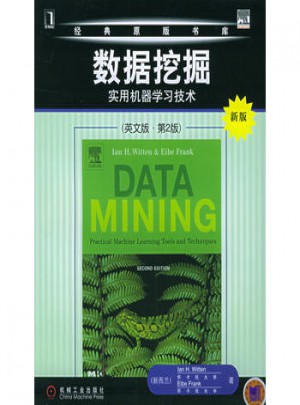

本书对1999年的初版做了重大的改动。虽说核心概念没有变化,但本书进行了更新使其能反映过去5年里的变化,参考文献几乎翻了一番。新版的重要部分包括:30个新的技术章节;一个加强了的具有交互式界面的Weka机器学习工作平台;有关神经网络的完整信息,一个有关贝叶斯网络的新节;等等。
本书提供了机器学习概念的完整基础,此外还针对实际工作中应用相关工具和技术提出了一些建议,在本书中你将发现:
●成功数据挖掘技术的核心算法,包括历经考验的真实技术及前沿的方法。
●转换输入或输出以改善性能的方法。
●可下载的Weka软件??一个用于数据挖掘任务的机器学习算法的集合,包括用于数据预处理、分类、回归、聚类、关联规则以及在新的交互式界面上可视化的工具。
"本书将这门新的学科用一种非常容易理解的方式呈现给读者:它既是一本用于培训新一代实践者和研究工作者的教科书,同时对于我这样需要不断充电的专业读者也具有启示作用。Witten和Frank热切追求的是简单而流畅的解决方案,他们时刻不忘将所有的概念都建立在具体实例的基础之上,促使读者首先考虑简单的技术,如果这些简单技术不足以解决问题,再进一步考虑更为高级和成熟的技术。
假如你想分析和理解数据,本书以及相关的Weka工具包将非常有用。"
――摘自微软研究院图灵奖得主Jim Gray所做的前言
Lan H.Witten新西兰怀卡托大学计算机科学系教授,ACM和新西兰皇家学会成员。他曾荣获2004年国际信息处理研究联合会颁发的Namur奖项,这是一个两年一度的荣誉奖项,用于奖励那些在信息和通信技术的社会应用方面做出杰现贡献及具有国际影响的人。他的著作包括《Managing Gi
Foreword
Preface
Part I Machine learning tools and techniques
1. What?s it all about?
1.1 Data mining and machine learning
1.2 Simple examples: the weather problem and others
1.3 Fielded applications
1.4 Machine learning and statistics
1.5 Generalization as search
1.6 Data mining and ethics
1.7 Further reading
2. Input: Concepts, instances, attributes
2.1 What?s a concept?
2.2 What?s in an example?
2.3 What?s in an attribute?
2.4 Preparing the input
2.5 Further reading
3. Output: Knowledge representation
3.1 Decision tables
3.2 Decision trees
3.3 Classification rules
3.4 Association rules
3.5 Rules with exceptions
3.6 Rules involving relations
3.7 Trees for numeric prediction
3.8 Instance-based representation
3.9 Clusters
3.10 Further reading
4. Algorithms: The basic methods
4.1 Inferring rudimentary rules
4.2 Statistical modeling
4.3 Divide-and-conquer: constructing decision trees
4.4 Covering algorithms: constructing rules
4.5 Mining association rules
4.6 Linear models
4.7 Instance-based learning
4.8 Clustering
4.9 Further reading
5. Credibility: Evaluating what?s been learned
5.1 Training and testing
5.2 Predicting performance
5.3 Cross-validation
5.4 Other estimates
5.5 Comparing data mining schemes
5.6 Predicting probabilities
5.7 Counting the cost
5.8 Evaluating numeric prediction
5.9 The minimum description length principle
5.10 Applying MDL to clustering
5.11 Further reading
6. Implementations: Real machine learning schemes
6.1 Decision trees
6.2 Classification rules
6.3 Extending linear models
6.4 Instance-based learning
6.5 Numeric prediction
6.6 Clustering
6.7 Bayesian networks
7. Transformations: Engineering the input and output
7.1 Attribute selection
7.2 Discretizing numeric attributes
7.3 Some useful transformations
7.4 Automatic data cleansing
7.5 Combining multiple models
7.6 Using unlabeled data
7.7 Further reading
8. Moving on: Extensions and applications
8.1 Learning from massive datasets
8.2 Incorporating domain knowledge
8.3 Text and Web mining
8.4 Adversarial situations
8.5 Ubiquitous data mining
8.6 Further reading
Part II: The Weka machine learning workbench
9. Introduction to Weka
9.1 What?s in Weka?
9.2 How do you use it?
9.3 What else can you do?
9.4 How do you get it?
10. The Explorer
10.1 Getting started
10.2 Exploring the Explorer
10.3 Filtering algorithms
10.4 Learning algorithms
10.5 Meta-learning algorithms
10.6 Clustering algorithms
10.7 Association-rule learners
10.8 Attribute selection
11. The Knowledge Flow interface
11.1 Getting started
11.2 Knowledge Flow components
11.3 Configuring and connecting the components
11.4 Incremental learning
12. The Experimenter
12.1 Getting started
12.2 Simple setup
12.3 Advanced setup
12.4 The Analyze panel
12.5 Distributing processing over several machines
13. The command-line interface
13.1 Getting started
13.2 The structure of Weka
13.3 Command-line options
14. Embedded machine learning
……
15. Writing new learning schemes
References
Index